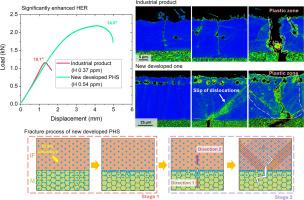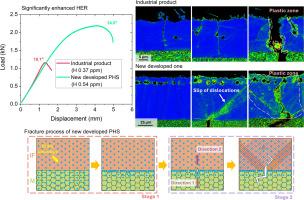Mitigating delayed fracture in AlSi-coated 2 GPa press-hardened steel via surface plasticity-induced hydrogen delocalization
IF 9.3
1区 材料科学
Q1 MATERIALS SCIENCE, MULTIDISCIPLINARY
引用次数: 0
Abstract
AlSi-coated 2 GPa press-hardened steel (PHS) has great potential for improving fuel efficiency in the automotive industry owing to its ultra-high strength. However, the ultra-high strength increases the hydrogen embrittlement risks and thus hinders its broad application. To mitigate its hydrogen embrittlement risks, a novel mechanism that is surface plasticity-induced hydrogen delocalization is proposed. While the conventional surface structure of industrial PHS composed of brittle intermetallics and interdiffusion ferrite (IF), exhibits negligible plasticity during the bending test, the newly developed PHS features a surface structure composed of ductile low-Al/Si IF, thereby activating substantial surface plasticity capable of enhanced plastic deformation energy storage. The enhanced surface plasticity enables the elimination of pre-existing cracks during thermal processing, coordinating multiple mechanisms including blunting of crack tip, expansion of plastic zone, twisting of crack propagation path, and the multiplication of hydrogen trapping sites in the surface structure during bending fracture. Consequently, both stress and hydrogen concentration near the main crack are noticeably alleviated, thereby mitigating the hydrogen embrittlement risks. Experiment results demonstrate that the hydrogen embrittlement resistance of the newly developed PHS is improved by more than twofold without sacrificing the tensile properties. This work provides a new pathway to mitigate the HE risks of 2 GPa AlSi-coated PHS and promotes its application in the automotive industry.


通过表面塑性诱导的氢离域减轻alsi涂层2gpa压硬化钢的延迟断裂
alsi涂层2gpa压硬化钢(PHS)由于其超高强度,在提高汽车行业燃油效率方面具有巨大的潜力。然而,超高强度增加了氢脆的风险,从而阻碍了其广泛应用。为了减轻其氢脆风险,提出了表面塑性引起的氢离域机制。传统的工业小灵通由脆性金属间化合物和互扩散铁素体(IF)组成的表面结构在弯曲试验中表现出可忽略不计的塑性,而新开发的小灵通具有由延性低al /Si IF组成的表面结构,从而激活了大量的表面塑性,能够增强塑性变形能量储存。增强的表面塑性可以消除热加工过程中存在的裂纹,协调多种机制,包括裂纹尖端的钝化、塑性区扩展、裂纹扩展路径的扭转以及弯曲断裂过程中表面结构中氢捕获点的增加。因此,主裂纹附近的应力和氢浓度都明显减小,从而降低了氢脆风险。实验结果表明,在不牺牲拉伸性能的情况下,新研制的小PHS的抗氢脆性能提高了两倍以上。本研究为降低2gpa alsi涂层小灵通的HE风险提供了新的途径,并促进了其在汽车工业中的应用。
本文章由计算机程序翻译,如有差异,请以英文原文为准。
求助全文
约1分钟内获得全文
求助全文
来源期刊

Acta Materialia
工程技术-材料科学:综合
CiteScore
16.10
自引率
8.50%
发文量
801
审稿时长
53 days
期刊介绍:
Acta Materialia serves as a platform for publishing full-length, original papers and commissioned overviews that contribute to a profound understanding of the correlation between the processing, structure, and properties of inorganic materials. The journal seeks papers with high impact potential or those that significantly propel the field forward. The scope includes the atomic and molecular arrangements, chemical and electronic structures, and microstructure of materials, focusing on their mechanical or functional behavior across all length scales, including nanostructures.
 求助内容:
求助内容: 应助结果提醒方式:
应助结果提醒方式:


